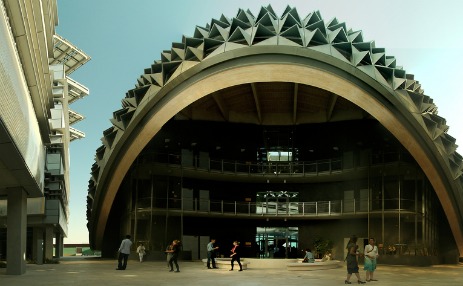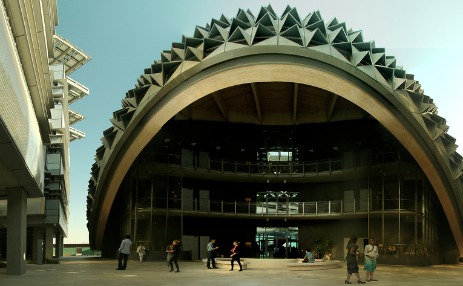 Smart cities like Masdar, in Abu Dhabi, are all the rage. But are they intelligent in the right way?Photo: Trevor PattCross-posted from the Natural Resources Defense Council.
Smart cities like Masdar, in Abu Dhabi, are all the rage. But are they intelligent in the right way?Photo: Trevor PattCross-posted from the Natural Resources Defense Council.
“Intelligent cities” and “smart cities” are all the rage right now, especially in corporate image advertising related to emerging technology. But is there a downside?
I think there may be, insofar as those phrases are used to describe tech-based panaceas for urban problems whose roots lie not in a lack of sophisticated information flow, but in a half-century or more of dumb growth patterns, central-city disinvestment, and poor neighborhood design.
Just a couple of days ago, I mentioned the clearly discernible trend of large, multinational corporations working to get ahead of the sustainability curve and position themselves as leaders in 21st-century management systems that can help cities. This is mostly a very good thing, since more forward thinking by corporations about solving our environmental and social problems can indeed help. Many of us have already seen how smart-phone apps of various kinds, real-time information at transit stops, and tech-based tools like Google Earth and Walk Score have empowered planners, civic leaders, and ordinary people like you and me to live and work better. More of this is to be applauded.
But futuristic technology won’t fix many of our basic urban problems, any more than “gizmo green” add-ons to buildings will overcome the unsustainability inherent in lousy building locations or lousy architecture. Sprawl will still be sprawl; disinvestment will still be disinvestment; traffic will still be traffic; sprawl-aided obesity will still be obesity.
Here’s my friend Steve Mouzon on “gizmo green”:
Gizmo Green, unfortunately, constitutes a huge percentage of today’s sustainability discussion. Buy compact fluorescent light bulbs. Buy a Prius. Buy some bamboo … and everything will be OK. Or will it?
The Gizmo Green focus allows us to ignore huge essential facets of sustainability that have nothing to do with equipment or materials. For example, why are we even discussing the carbon footprint of a building if it is built somewhere that requires you to drive everywhere? Or what is the value of the carbon footprint of a building once its parts are carted off to the landfill because it could not be loved?
I believe the very same principles apply to “gizmo cities.”
So forgive me if I think some of the marketing for this mostly-good gadgetry is over the top, and if I find to be dangerous the claims of some that the more trendy phrasing and theory of “intelligent cities” is beginning to displace that of now-mainstream “smart growth.” Whether we call more compact and logical regional growth patterns, more accessible and efficient public transit, and more walkable neighborhood design “smart growth” or “urbanism” or something else, we still need to do it and not let ourselves be seduced into thinking that the problems are being addressed adequately or better by technology. They are not.
Brent Toderian, Vancouver’s planning director, agrees:
Although many such products sound useful, this feels like part of the “technology will save us” movement, which in its worst moments, uses up city funds while giving cities “permission” not to make the hard choices that will really work to make us more resilient and successful. This seems more common in America than elsewhere, where the feeling that the marketplace will respond and provide products to fix problems still has resonance.
At a conference late last year in Spain, I found myself on panels discussing new technologies that will improve cities, surrounded by tech-company reps hard-pitching to a global audience. I likely disappointed them, by stating that in my opinion the “technologies” that will do the most good, are not new — compact, mixed-use, walkable communities; bikes, separated bike lanes, and bike sharing; transit; small scale innovation like wheeled luggage; simple techniques that we’ve forgotten like passive building design; or globally-understood tech like district/neighborhood energy based on renewable resources. But those big companies weren’t selling those products. They were selling smart city solutions.
Vancouver has had the benefit of good planning now for some time, and there is little question that the city has been doing something right: Scoring 140 cities worldwide on 30 key factors, The Economist just named it the most livable city in the world, for the third straight year. I’m sure Brent wouldn’t claim credit for that (nor would he deserve all of it), but the work of his office is absolutely a contributing factor in making his city more hospitable and functional.
I am certainly not opposed to technology. I’m writing this on a high-powered computer, whose broadband connection and interface with Google just enabled me quickly to track down Steve’s and Brent’s quotes, plug them into this narrative, and store the whole thing to a flash drive, so later I can plug this post into NRDC’s blogging software. When it’s published, I’ll let my Facebook friends and Twitter followers know. Long live high-tech, say I. But, in the meantime, let’s don’t forget the basics.



